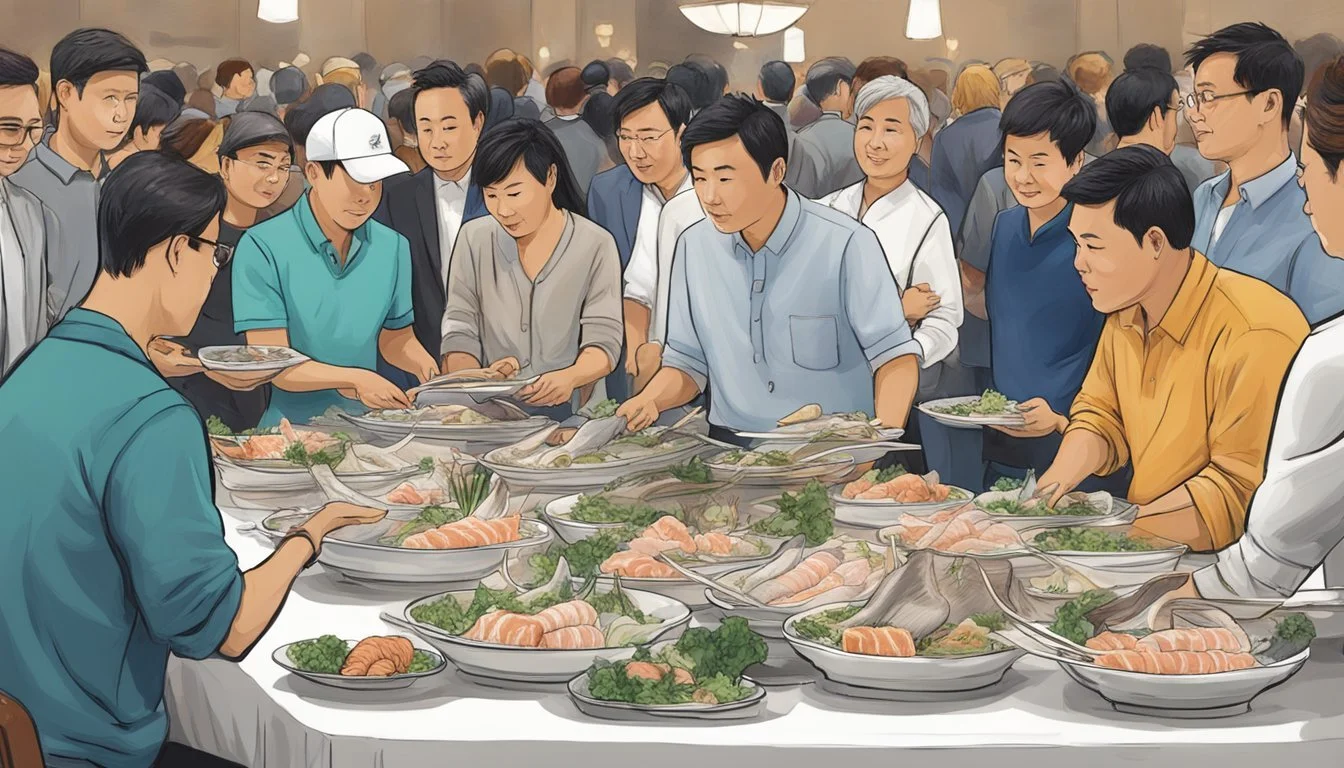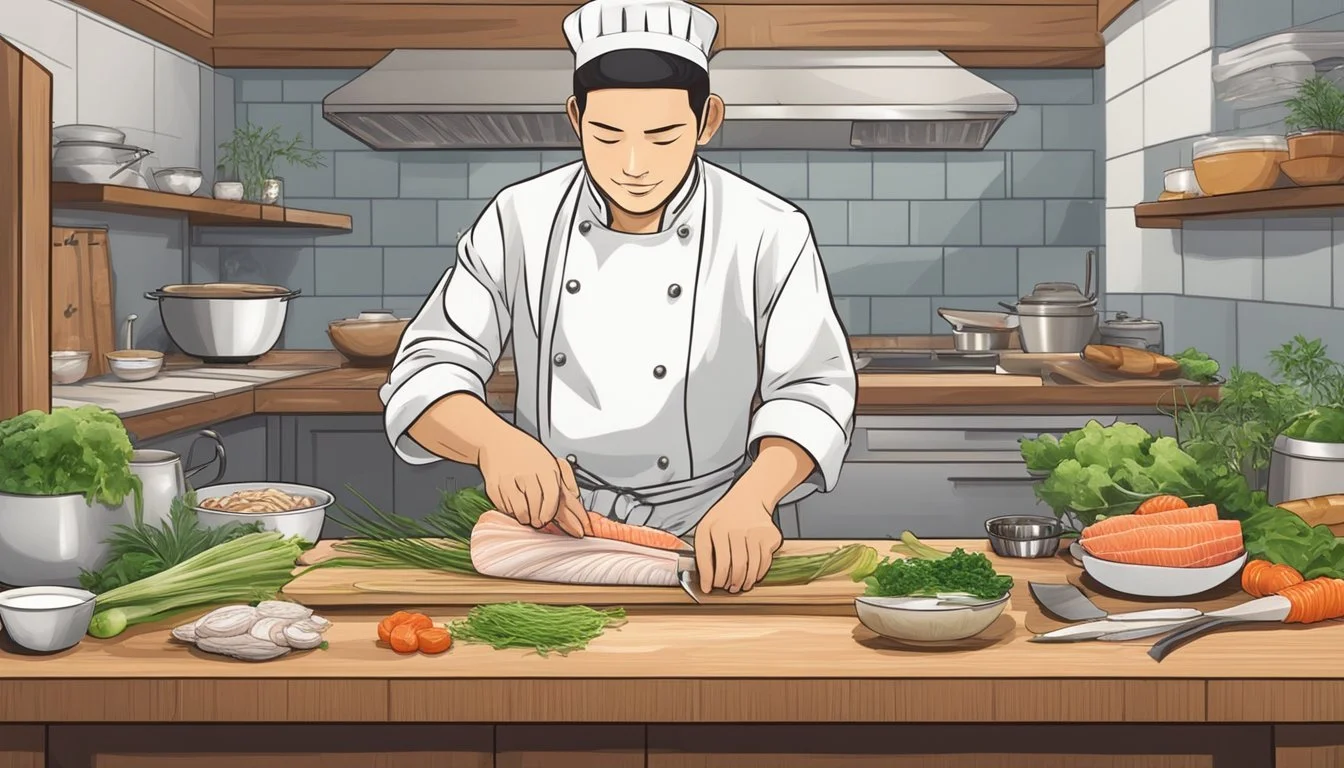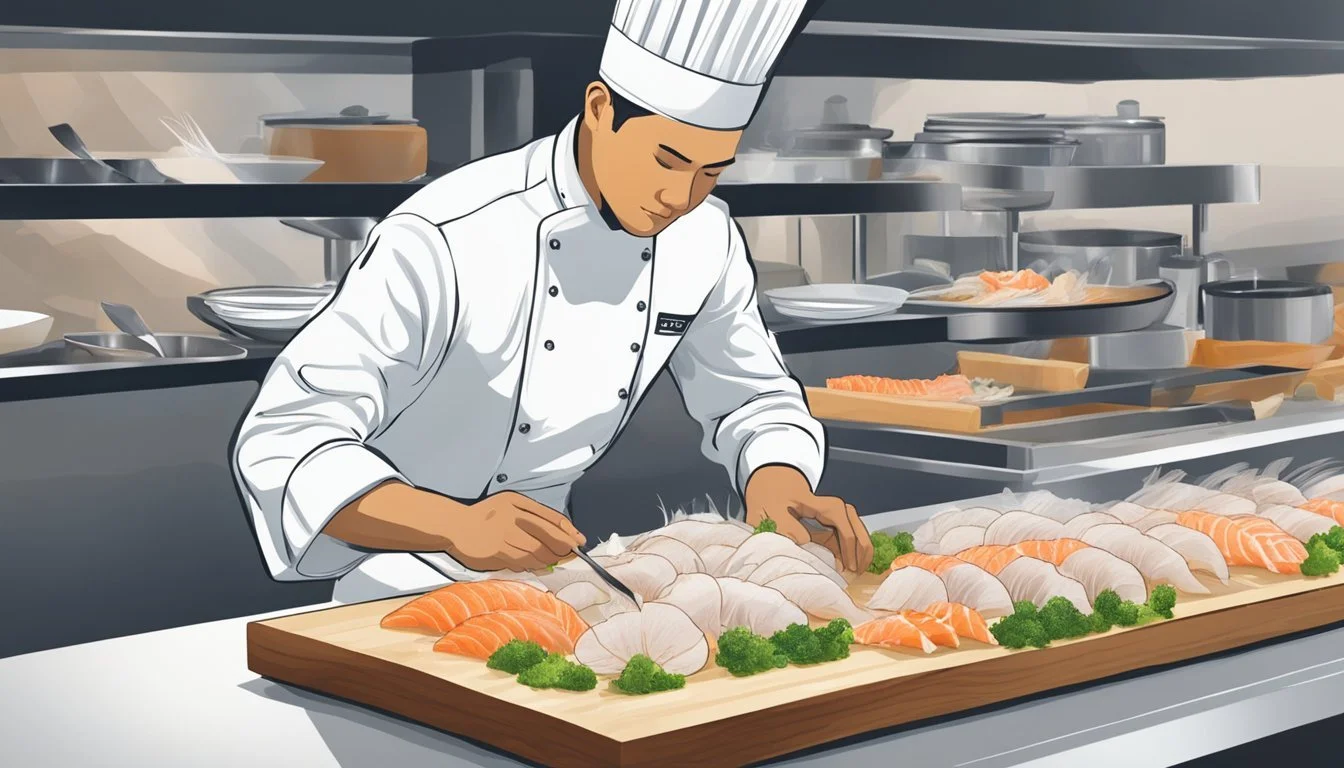Washington: The Geoduck Sashimi Challenge
A Culinary Adventure
The culinary daring of Washington State often finds expression in the form of geoduck sashimi, a dish that challenges both the chef's skill and the diner’s palate. This Pacific Northwest delicacy, harvested from the waters of Puget Sound, is known for its distinctive taste and texture. Geoduck (pronounced "gooey duck") is not your average clam; it's the world’s largest burrowing clam, with a long siphon that sticks out of its shell, making it an unusual and often visually striking feature on any plate.
In Washington’s seafood (What wine goes well with seafood?) circles, geoduck’s appeal lies in its unique combination of flavors and textures, which are best appreciated in the simplicity of sashimi. Chefs across the region slice the siphon thinly, often piling it atop lemon slices to create a dish that's as aesthetically pleasing as it is palate-pleasing. Its mild, sweet flavor profiles and a crisp texture have turned the geoduck into a sought-after experience for food enthusiasts venturing into the realm of raw seafood.
The geoduck has played a role not only in Washington’s gastronomy but also in its economy, with significant contributions to the state's seafood industry. The substantial sustainable fisheries of the Pacific Northwest ensure a steady supply of this unusual clam, supporting both commercial fisheries and local dining establishments eager to showcase the versatility of Washington's marine offerings.
The Geoduck: An Overview
The geoduck is a unique marine creature, noteworthy for its size and the industry it supports. This section delves into the specifics of the geoduck's anatomy, its habitat and range, and the role of aquaculture in sustaining its populations.
Anatomy of the Geoduck
The geoduck (Panopea generosa) is recognized by its sizable, elongated siphon and a large, meaty body which can weigh between two to seven pounds. Its shell is relatively small in proportion to its body. Most distinctive is the siphon, which can extend over a foot in length, making the geoduck an unusual sight among clams (What wine goes well with clams?).
Habitat and Range
Geoducks thrive in the sandy bottoms of the Pacific Northwest, particularly in the inland marine waters of Puget Sound, British Columbia, and Alaska. These burrowing clams can be found at depths ranging from intertidal to over 100 meters, where they embed themselves tail-first into the sediment using their powerful siphons.
Geoduck Aquaculture
Aquaculture is crucial for sustaining the geoduck population and supporting the region's business interests, including the influential Taylor Shellfish (What wine goes well with shellfish?) company. Farmed geoducks are cultivated in Puget Sound by both commercial enterprises and indigenous tribes, reflecting a blend of modern techniques and traditional practices that contribute to the geoduck's economic and cultural significance.
Geoduck Sashimi: A Culinary Delight
Geoduck sashimi is a prized dish known for its unique texture and rich flavor. This section explores the preparation, cultural importance, and nutritional benefits of this distinctive seafood delicacy.
Serving Geoduck Sashimi
Preparing geoduck sashimi requires a meticulous process to accentuate its subtle flavors and delicate texture. The siphon should be skinned carefully, then the geoduck should be rinsed and thinly sliced to achieve a melt-in-the-mouth experience. Served typically with soy sauce, wasabi, and sometimes a touch of sake, the dish allows the natural essence of the raw geoduck to shine. For more insights on the recipe, Tastylicious provides a simple approach to crafting this dish at home.
Cultural Significance
In Japanese cuisine, sushi and sashimi are more than just food; they are an art form where every element has its place, and geoduck sashimi is no exception. Revered for its succulent texture and flavor, geoduck has become an icon in the seafood world, offering a taste of the Pacific Northwest to tables around the globe. Its intrigue is not just in taste but also in the cultural experience it offers, embodying the tradition of fresh, raw delicacies that has been a cornerstone in regions like Japan.
Nutritional Profile
Geoduck is not only notable for its gastronomic appeal but also for its nutritional value. Rich in protein and low in calories and fat, it is an excellent choice for those seeking a healthy diet. It also boasts a wealth of minerals such as calcium, potassium, and sodium, along with vitamin C, rounding out its benefits as a wholesome food. To understand the specifics of what this shellfish offers, consider the following breakdown:
Calories: Low
Protein: High
Fat: Low
Vitamin C: Present
Calcium: Good source
Potassium: Good source
Sodium: Moderate
Savoring geoduck sashimi can be both an indulgence for the palate and a contribution to wellbeing.
Preparing Geoduck
Before one embarks on the culinary journey of preparing geoduck, it is essential to know the proper techniques for cleaning and preparing this unique seafood. It's equally important to master various cooking methods to best appreciate the geoduck clam's texture and flavor.
Cleaning and Preparation
To ensure the geoduck is ready for any recipe, it needs thorough cleaning. Firstly, the shell must be detached and the stomach removed. For the siphon and body meat, a brief blanching in hot water for about 10 seconds, followed by an immediate cool down in an ice bath is recommended. This process makes the skin easy to peel off. Once the skin is removed, one can separate the siphon from the body. The siphon is often sliced in half lengthwise, revealing the tender meat inside, ready for further preparation.
Step 1: Remove shell and stomach.
Step 2: Blanch siphon and body in hot water.
Step 3: Cool immediately in ice bath.
Step 4: Peel skin off the siphon and body.
Step 5: Separate siphon from the body and slice accordingly.
Cooking Techniques
When it comes to cooking, the geoduck clam responds well to a variety of techniques. One can opt to thinly slice the siphon for a classic sashimi presentation, allowing the subtle flavors and firm, crunchy texture to shine without overwhelming seasoning. Alternatively, a quick sauté in browned butter with a splash of wine can enhance the geoduck's sweetness, transforming it into a tender, flavorful treat. Geoduck can also be a stellar addition to a hot pot, adding its signature taste and texture to the broth as it cooks briefly in the simmering liquid.
Sashimi: Thinly slice and serve raw for a direct taste of the sea.
Sauté: Cook slices swiftly in browned butter and wine.
Hot Pot: Immerse in hot broth, cooking briefly for a delicate taste.
Taking care when cleaning and selecting the right cooking technique ensures the geoduck's flavor and texture are presented at their best. Whether enjoyed raw or cooked, the geoduck is sure to offer a unique and savory seafood experience.
Geoduck in World Cuisine
The renown of geoduck extends beyond its native Pacific Northwest, featuring prominently on international menus and fueling a robust demand in global markets.
Geoduck on Menus Abroad
In Japan, geoduck is savored in its purist form as sashimi. It is delicately sliced to showcase its unique texture and often accompanied by a refreshing spritz of yuzu, enhancing the clam's natural sweetness. Renowned establishments in Tokyo feature geoduck sashimi as a testament to the skill of their chefs and the quality of their seafood offerings.
Across the Pacific, in British Columbia, restaurants specialize in innovative geoduck dishes that reflect the region's diverse culinary influences. One might find geoduck paired with local ingredients, taking a place of pride on the seafood platter amid a melange of the region's best offerings.
International Trade and Demand
The demand for geoduck is especially high in China, where its status as a luxury seafood has made it a sought-after item. Geoduck is typically imported live to ensure freshness, and it can command high prices at market. This demand has had a notable effect on export trade, with suppliers and fisheries developing sophisticated techniques for sourcing and transporting geoduck securely.
Trade figures underscore the importance of geoduck in international commerce, with exports from Washington and British Columbia making up a significant portion of the market. The interplay between supply and rising demand continues to shape the geoduck industry, promising a dynamic future for this unique component of world cuisine.
Conservation and Regulation
The conservation and regulation of Washington's geoduck resources focus on maintaining a balance between the thriving market demand and the need for ecological sustainability. These measures are crucial to ensure that both wild and farmed geoduck populations remain healthy and viable for future generations.
Sustainable Harvesting
The Department of Natural Resources (DNR), in partnership with the Washington Department of Fish and Wildlife, takes a methodical approach to the harvesting of wild geoducks. They employ stringent criteria to determine an allowable catch that is ecologically sustainable. This involves regular assessments of geoduck populations in their natural habitats to establish the optimal harvest levels. Farmed geoducks, on the other hand, are cultivated on tidelands and are subject to a different set of sustainability practices, such as limiting farm sizes and protecting the surrounding marine ecosystem.
Regulatory Framework
Regulations governing the geoduck fisheries are underpinned by scientific research and collaborative management. The state of Washington and the Puget Sound Treaty Indian Tribes each have rights to 50 percent of the sustainable harvest. The DNR offers the state's portion for harvest through public auctions. Moreover, to maintain harmony with the habitat, geoduck aquaculture operations are regularly monitored, with best practices implemented to minimize their ecological footprint. Iron levels, along with other environmental factors, are monitored to prevent contamination and to preserve the pristine conditions necessary for a thriving geoduck population.
Economic Impact
The Pacific Northwest has seen a significant rise in geoduck aquaculture, which has become a lucrative business, especially considering the high demand for geoduck clams in Asian markets. In Washington state, the harvesting of geoducks contributes robustly to the local economy, with businesses prying an estimated 5 million pounds of geoducks from state waters annually. This substantial harvest underpins a thriving export sector centered on marine life considered a delicacy in regions like Asia.
The expansion of geoduck farming along Washington's private tidelands signifies the potential for economic growth in the aquaculture industry. With each average geoduck weighing about 2 pounds and fetching prices that can reach up to $100 per pound overseas, the financial implications are significant for local communities and investors. However, the increased activity has also led to ecological and regulatory challenges, prompting a series of public meetings to discuss the future of geoduck farms.
Despite these challenges, the popularity of geoduck, especially in high-end culinary markets like China, motivates continuous investment in the industry. Yet, geopolitical tensions such as trade disputes can impact the industry's stability; for instance, the trade war with China led to a "crushing" effect on Washington's geoduck business, showcasing the vulnerability of relying heavily on export markets.
Washington's tide toward economic reliance on geoduck aquaculture is clear, but maintaining a balance between economic benefits and sustainable practices remains a pivotal challenge for the industry's long-term viability.
Culinary Innovations and Trends
Innovative culinary trends often showcase unique ingredients like geoduck, which chefs incorporate into traditional and modern dishes, enhancing menus with both nutritious and exotic offerings.
Fusion Dishes and Experiments
Contemporary menus celebrate the fusion of global flavors with local seafood staples, turning a spotlight on geoduck. This large clam, known for its pronounced siphon, is a feature in both traditional and avant-garde dishes. Sashimi serves as a canvas for its mild, crisp qualities, with chefs thinly slicing raw geoduck to appreciate its natural taste and texture uncompromised.
On the other hand, culinary adventurers have experimented with cooking geoduck, incorporating it into heartier meals like chowder. Here, the geoduck's soft body is fully cooked, turning it into a rich addition to the creamy soup, contrasting the chewier texture when it's served raw.
Geoduck's nutritional value also garners attention; being low in fat and high in protein, it's considered a healthy seafood choice. Whether it is prepared raw or cooked, chefs are pushing boundaries, confirming that this Pacific Northwest gem can adapt to a range of cooking styles while preserving its unique characteristics.
Consumer Guidance
When choosing to enjoy geoduck, particularly in the delicate form of sashimi, precise selection, storage, and understanding of its nutritional profile are essential for both safety and enjoyment.
Selecting and Storing Geoduck
To experience the best of geoduck's unique taste, ensuring freshness is crucial. One should look for geoducks with a firm and intact shell, avoiding any with an unpleasant odor or damaged exterior. Once selected, proper storage is key—geoduck should be kept in the refrigerator, ideally within a bowl covered with a damp cloth, and should be consumed within two days for optimum freshness.
Health Considerations
Geoduck is a nutritious seafood choice, offering a significant amount of protein with minimal fat. It also contains traces of vitamin C, among other nutrients. Consumers should, however, be mindful of cleanliness and safety when preparing geoduck at home to avoid food-borne illnesses; thorough washing and careful handling are imperative. For those who are pregnant or have compromised immune systems, consulting a healthcare provider before consuming raw seafood like geoduck sashimi is advisable. When prepared correctly, geoduck can be a safe and delightful addition to one's cooking repertoire.
Conclusion
The culinary exploration of geoduck, particularly in the form of sashimi, is a noteworthy experience in Washington. This region, known for its bountiful seafood, takes pride in the unique texture and flavor that geoduck sashimi offers. Chefs in Washington expertly slice the geoduck into thin pieces, presenting it atop crisp, fresh lemon, or simply complemented with soy sauce and wasabi.
The geoduck clam is not just a giant clam; it is one of the world's largest burrowing clams, cherished for both its taste and its texture. The geoduck's infrequent appearance on menus outside of the Pacific Northwest adds to its allure, making its sashimi a sought-after dish for culinary adventurers.
Visitors to Washington seeking an authentic and memorable culinary experience should not miss the chance to sample geoduck sashimi. They'll find that despite its peculiar appearance, the geoduck has a satisfying crispness and a mild sea flavor, rare qualities that can only be fully appreciated through taste.
In essence, the geoduck represents a slice of Washington's rich marine culture, inviting diners to savor a part of the local heritage. It stands as a testament to the area's gastronomic diversity and the innovative spirit of its culinary community.






